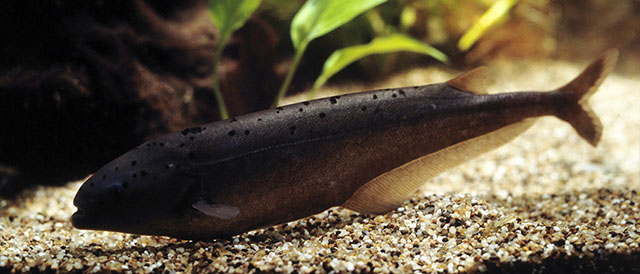| Mormyridae (Elephantfishes) |
| 51 cm SL (male/unsexed); max.weight: 1,000.0 g |
|
demersal; freshwater; brackish, potamodromous |
| Africa: all Sahelo-Sudanese river basins (Ref. 81274), including the Senegal, Gambia, Niger, Volta, Ouémé, Ogun and Chad (Ref. 2915). Also in the Nile basin, up to the Albert and Murchison Niles (Ref. 3203). |
|
Dorsal spines (total): 0-0; Dorsal soft rays (total): 12-16; Anal spines: 0-0; Anal soft rays: 52-71. Diagnosis: body depth 3.5-6.2 times in SL, head length 4.5-6.2 times (Ref. 2915, 4903, 81274). Head length 1.6-2.3 times greater than its width (Ref. 2915, 81274) and 6-13.5 times greater than eye diameter (Ref. 81274). Dorsal head profile strongly curved (Ref. 4903), rounded, snout short, thick and blunt (Ref. 81274). Eye small, diameter 1/6 (in young fishes) to 1/9 of head length in adults; mouth small and terminal, teeth notched, 3-5 in upper and 4-6 in lower jaw (Ref. 4903). Anal fin with 52-71 rays, its origin about equidistant from snout tip and caudal-fin base (Ref. 81274). Dorsal fin very short (Ref. 28714, 81274), one fifth or less of the anal fin length (Ref. 4903, 28714), with 12-16 rays (Ref. 4903, 81274) of which the first 2-3 unbranched (Ref. 4903). Anal-fin base 4-7.7 times longer than dorsal-fin base; pectoral fins 1.1- 1.7 times in head length; pelvic fins about half as long as the pectorals (Ref. 2915, 81274). 90-120 lateral line scales (Ref. 4903, 81274) and 16-20 (exceptionally 22) around caudal peduncle (Ref. 81274). Depth of caudal peduncle 1.5-3.6 times in its length (Ref. 2915, 81274).
Coloration: ground color silvery, back darker, olivaceous, brownish or yellowish, with scattered black dots in adults; belly greyish; neck greyish or white; fins greyish (Ref. 81274). |
| Inhabits both still and flowing waters; breeds in the flood season; feeds on mollusks (Ref. 28714). Possesses electroreceptors over the entire head and on the ventral and dorsal regions of the body, but absent from the side and the caudal peduncle where the electric organ is located (Ref. 10011). Its electric organ discharge (EOD) is steroid-sensitive (Ref. 10763; 10764). Fecundity value of 18,924 eggs has been reported for this species (Ref. 10607). |
|
Least Concern (LC); Date assessed: 23 October 2019 Ref. (130435)
|
| harmless |
Source and more info: www.fishbase.org. For personal, classroom, and other internal use only. Not for publication.

